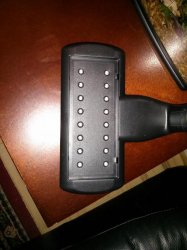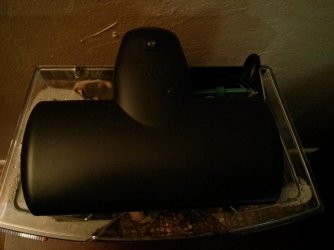Not at all, also this guide states for all algae problems some imbalance in nutrition (CO2 is also nutrition).levahe said:The idea that excess nutrients causes algae is old out of date info and is incorrect,
Check out this algae guide,
http/www.theplantedtank.co.uk/algae.htm
You are using an out of date browser. It may not display this or other websites correctly.
You should upgrade or use an alternative browser.
You should upgrade or use an alternative browser.
Lighting: How Long Each Day?
- Thread starter pnyf
- Start date
April FOTM Photo Contest Starts Now!

🏆 Click to enter! 🏆
three-fingers
Fish Connoisseur
Could you take a pic of the light or give any info on the tank model? Chances are if its a cheap LED that came with the small tank you wont need to do anything, as it will have a low PAR rating anyway. This means that while it may look very bright to our eyes, the light contains very little photosynthetically active radiation, so algae and plants will only grow slowly.pnyf said:The tank came with a light that has 2 rows of LED lights. Other than that I don't know too much about it. It seems bright
I think I'll get a timer and start by cutting down the amount of time I have the light on and go from there.
Imbalance = fluctuating or too little, but never too much
Not at all, also this guide states for all algae problems some imbalance in nutrition (CO2 is also nutrition).
Excess nutrients are good for the plants and therefor bad for the algae
The light is the stock one that came with the kit. Its a Marineland Crescent 3. It has 2 rows of LEDs with 8 lights on each row. The box isn't very helpful as to what kind of lights they are other than being LED. I took a quick picture from the top and bottom if its helpful at all.
Attachments
OP - Start at 6 hrs and start ramping it up over a few weeks. You can split it if you like and have a little longer from the start, but make the split decent like 4hrs.
IMO
As mentioned above, you'll see that EI fits very well in to that system and it's been proven countless times. Technically if you choose to limit somthing random like molybdenum you could control the plant growth (liebig again) but you'd still have to guarentee the plants overall wellbeing. Much easier to do the nutrients > CO2 > light thing.
IMO
Check out Liebig's law of the minimum and factor in light/CO2 you'll see that if you take light as the lowest stave on the barrel with CO2 above that and then any nutrient above that still you'll have healthy plants. And in a tank it's the healthy plants taht tend to dictate the algae. Ideally you want an "imbalance" of nutrients - Heavy on plant food, lighter on CO2 and Light the least of all.hobby5 said:Not at all, also this guide states for all algae problems some imbalance in nutrition (CO2 is also nutrition).
As mentioned above, you'll see that EI fits very well in to that system and it's been proven countless times. Technically if you choose to limit somthing random like molybdenum you could control the plant growth (liebig again) but you'd still have to guarentee the plants overall wellbeing. Much easier to do the nutrients > CO2 > light thing.
three-fingers
Fish Connoisseur
As I suspected, no need to bother messing with light timings!pnyf said:The light is the stock one that came with the kit. Its a Marineland Crescent 3. It has 2 rows of LEDs with 8 lights on each row. The box isn't very helpful as to what kind of lights they are other than being LED. I took a quick picture from the top and bottom if its helpful at all.
The first clue was that the blurb advertising the LED mentions nothing about plant growth, then I found this answer on the Marineland website:
So with 16 LEDs in the fixture, you only have 0.96 watts of LED light, and the PAR reading at the bottom of the tank will be very, very low, since its not designed for growing plants.Each bulb is .06 watts or 60 milliwat. The lights are 6,000 Kelvin.
Java fern and Java moss are low-light plants but IMO that may be too little if the rooms dark, you'll want to keep an eye on them over time to see that they actually growing, and not just stretching to find light! Strange as this sounds, if your plants start struggling due to low light, that will induce algae growth.
The good news is the algae will grow very, very slowly too
 . But yeah, messing around with timers for this LED wuld be a waste of time IMO.
. But yeah, messing around with timers for this LED wuld be a waste of time IMO.So with 16 LEDs in the fixture, you only have 0.96 watts of LED light, and the PAR reading at the bottom of the tank will be very, very low, since its not designed for growing plants.three-fingers said:
As I suspected, no need to bother messing with light timings!The light is the stock one that came with the kit. Its a Marineland Crescent 3. It has 2 rows of LEDs with 8 lights on each row. The box isn't very helpful as to what kind of lights they are other than being LED. I took a quick picture from the top and bottom if its helpful at all.
The first clue was that the blurb advertising the LED mentions nothing about plant growth, then I found this answer on the Marineland website:
Each bulb is .06 watts or 60 milliwat. The lights are 6,000 Kelvin.
Java fern and Java moss are low-light plants but IMO that may be too little if the rooms dark, you'll want to keep an eye on them over time to see that they actually growing, and not just stretching to find light! Strange as this sounds, if your plants start struggling due to low light, that will induce algae growth.
The good news is the algae will grow very, very slowly too
Thats good to know. I'll keep an eye on the plants and make sure they are doing all right. Thanks for your help.
Okthree-fingers said:Imbalance = fluctuating or too little, but never too much
Not at all, also this guide states for all algae problems some imbalance in nutrition (CO2 is also nutrition).. Lack of CO2 or other nutrients can cause algae if theres too much light, too little flow will cause algae because the available nutrients aren't being distributed around the tank to the plants.
Excess nutrients are good for the plants and therefor bad for the algae.
Is there any idea, what hinders the algae to grow on excess nutrients if available?
three-fingers
Fish Connoisseur
A large biomass of healthy established plantsIs there any idea, what hinders the algae to grow on excess nutrients if available?
Personally, in aquariums, I believe it also has a lot to do with allelopathy, as Diana Walstad discusses in Ecology of the Planted Aquarium. Basically, growing plants produce chemicals that kill or stunt the growth of algae as a result of healthy metabolism.
Algae, being unicellular, adapt more quickly to change than plants do. That's why it's only when nutrients are fluctuating that it has an advantage over plants, or of course if you have too little of any one nutrient, the plants are no longer maintaining a healthy metabolism due to the deficiency so lose their allelopathic defence.
Latest Discussions
- Replies
- 6
- Views
- 27
- Replies
- 9
- Views
- 84
trending
-
-
-
-
How many batches of fry can a mutt guppy have in their lifetime? How about wild types? Kept track of a single female's total progeny?
- Started by AdoraBelle Dearheart
- Replies: 14
-
Staff online
-
GaryEModerator



